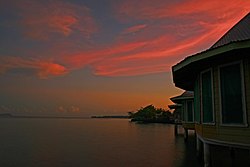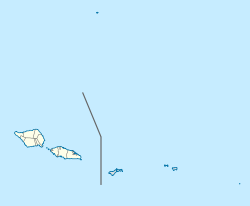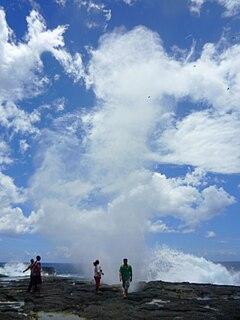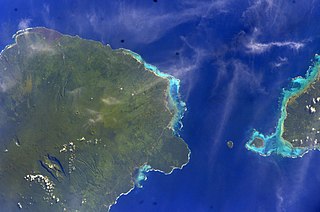| Sapapali'i | |
|---|---|
| Village | |
Sunset at Sapapali'i | |
| Coordinates: 13°41′21″S172°11′11″W / 13.68917°S 172.18639°W Coordinates: 13°41′21″S172°11′11″W / 13.68917°S 172.18639°W | |
| Country | |
| District | Fa'asaleleaga |
| Population (2006) | |
| • Total | 868 |
| Time zone | -11 |
Sapapali'i is a village on the north east coast of Savai'i island in Samoa. It is the village where John Williams, the first missionary to bring Christianity to Samoa landed in 1830. [1] Sapapali'i is in the Fa'asaleleaga political district. [2]

Savaiʻi is the largest and highest island in Samoa and the Samoan Islands chain. The island is the fifth largest in Polynesia, behind the two main islands of New Zealand and the Hawaiian Islands of Hawaii and Maui.

Samoa, officially the Independent State ofSamoa and, until 4 July 1997, known as Western Samoa, is a country consisting of two main islands, Savai'i and Upolu, and four smaller islands. The capital city is Apia. The Lapita people discovered and settled the Samoan Islands around 3,500 years ago. They developed a unique Samoan language and Samoan cultural identity.

John Williams was an English missionary, active in the South Pacific. Born at Tottenham, near London, England, he was trained as a foundry worker and mechanic.
Sapapali'i became the second Malietoa base in the district in 1750 when Malietoa Ti’a married a woman from the village. Their son Malietoa Fitisemanu was the father of Malietoa Vaiinupo who received Williams in 1830. [3]

Malietoa King is a state dynasty and chiefly title in Samoa. Literally translated as "great warrior," the title's origin comes from the final words of the Tongan warriors as they were fleeing on the beach to their boats, "Malie To`a, Malo e tau".. great warrior, thank you for the war.
Sapapali'i is 8 km north of Salelologa ferry terminal and township.

Salelologa is a village district at the east end of Savai'i island in Samoa. It is the main entry point into the island with the only ferry terminal on Savai'i. It also serves as the main township for shopping and public amenities with a market selling fresh produce and arts and crafts.















